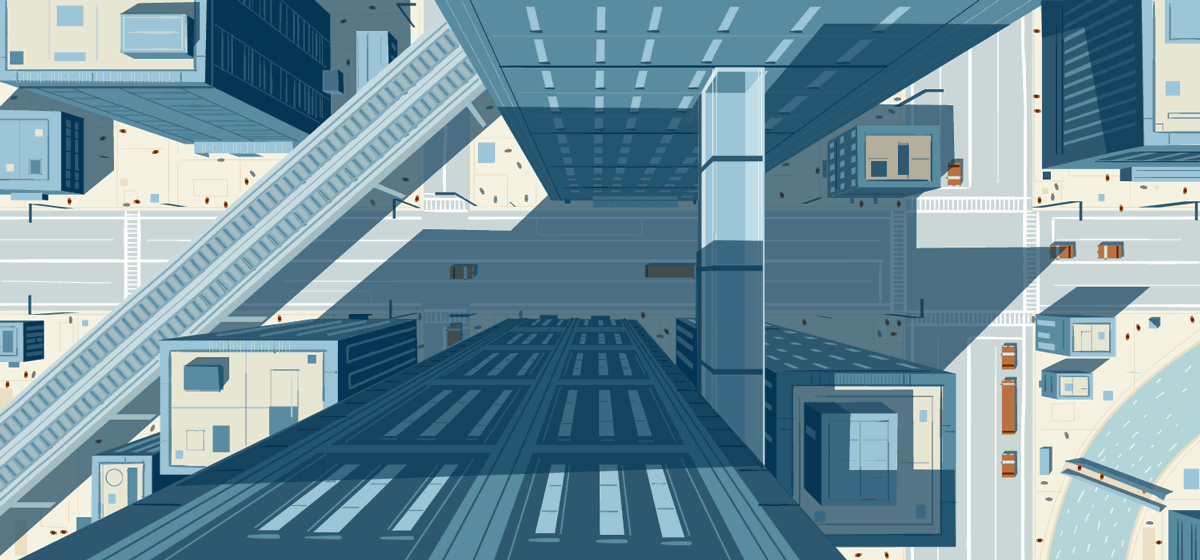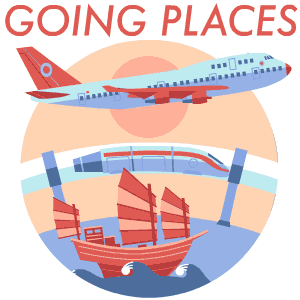

Technology and transportation have always been intertwined. Our earliest ancestors discovered that shoe-like foot coverings allowed them to walk farther along paths like the Laetoli and the Natchez Trace, carrying goods to trade with increasingly distant cultures and necessitating the creation of currency.
The wheel was invented in the late Neolithic Era for pottery, but it was soon adopted for travel. While the Romans built 53,000 miles of roads across their empire, allowing for fast movement of troops and goods, the most sophisticated ancient roads were found in Baghdad around the fifth century A.D., paved with tar from the early distillation of oil.
In the Pacific, dugout canoes performed the same role that roads did in Eurasia, allowing communities to travel and trade resources. The Ancient Egyptians were the first recorded civilization to have knowledge of sail construction, and many integral technologies–from chronology to meteorology–were first developed for maritime use.
The Ancient Greeks harbored aspirations of flight, as is evident in the tale of Daedalus and Icarus, but it was Chinese inventors around the same time that were able to get the first man-made flying object off the ground–a kite. The first man to survive flight may well have been Yuan Huangtou, a Chinese prince who was flown against his will from a tower on a large kite.
The Ancient Chinese can also be credited with the invention of the helicopter, which was a children’s toy, and the hot air balloon–creating flying lanterns that were used for military signaling. That same principle was rediscovered by the Montgolfier Brothers in the 18th century, around the same time that the discovery of hydrogen permitted the hydrogen balloon. It wasn’t until 1903–a mere century ago–that the Wright Brothers finally sustained, controlled, and powered heavier-than-air flight.
In our Going Places section, we explore in depth how transportation has shaped our world, and how it’ll shape our future. This reading list will get you up to speed with the contemporary discussions around the topic.

“The problem with traffic is that the people of today are driving the cars of tomorrow on the roads of yesterday.”
–Bob Talbert, Detroit Free Press, 1987

Start Here
In 2014, The Atlantic‘s CityLab dedicated nine months to looking at the future of transportation in the United States. Eric Jaffe‘s roundup of all of those stories, “The Future of Transportation Is Not All Flying Cars,” is a vital read to understand what to expect in the coming years. Here’s an excerpt:
In the brightest scenario, driverless technology combines with smartphone-based, on-demand taxi service to all but eliminate car-ownership within the city and complement transit access in the suburbs. In the dimmest, the ceaseless flow of driverless traffic might grind our streets to a halt, and we’ll be wishing for flying cars after all.
The full article is a great, short read packed with links to find out more. If you only read a single item on our list, this is the one.

Then Try
Our editorial team recommends these reads:
- Ian Steadman offers a New Statesman story called “How Mistakes Can Saves Lives” [32-minute read] about the way airline pilot checklists have reduced death rates in surgery. “It’s an example of how transport isn’t just moving things around (as important as that is), but also an area of study with lessons for other fields that can often be unexpected and profound.”
- Abigail Ronck chooses “Fleeing Terror, Finding Refuge” [10-minute read] from National Geographic. “I’ve long been fascinated by Paul Salopek’s experiment with slow journalism by walking through the world over many years and reporting on foot,” she says. “Here, he really lives his subjects’ reality, reminding us that in many cases life as a refugee starts on foot, with nothing but your legs.”
- Duncan Geere selects “Like Being in Prison With a Salary” [20-minute read], an excerpt from Rose George’s book Ninety Percent of Everything, published by Longreads. “It gives a fantastic overview of the way modern shipping operates,” he says. “It’s one of the most important industries in the world, but we never see it.”
- Kristen Taylor wants you to check out James Somers‘ “Why New York Subway Lines Are Missing Countdown Clocks,” [31-minute read] from The Atlantic. “The A in many transit name acronyms stands for “‘Authority,’ and the passengers need to believe in the agency’s competence,” she says.
- Finally, Darren Garrett selects “Disney’s Magic Highway” [9-minute watch], a 1958 animation showing the history and future of roads and travel in America. “My god, it is lovely,” he says.

Dive Deeper
- “The Box That Built the Modern World“
Andrew Curry, Nautilus [17-minute read] - “Exodus“
Ross Andersen, Aeon Magazine [34-minute read] - “Helium Dreams: A New Generation of Airships Is Born“
Jeanne Marie Laskas, The New Yorker[30-minute read] - “I Spent 18 Hours in Tel Aviv’s Bus Station“
Naomi Zeveloff, Forward [24-minute read] - “What 50 Years of Bullet Trains Have Done for Japan“
Joe Pinsker, The Atlantic [3-minute read] - “No Parking Here“
Clive Thompson, Mother Jones [33-minute read] - “The Unbelievable Reality of the Impossible Hyperloop“
Ryan Bradley, MIT Technology Review [30-minute read] - “Inside the Shady, Dangerous Business of Shipbreaking“
Eric Grundhauser, Atlas Obscura [6-minute read] - “My First Experience on Public Transportation“
sunday Parker [7-minute read] - “The World’s Biggest Camel Fair“
David Notes, TRVL [12-minute read] - “How to Spend 47 Hours on a Train and Not Go Crazy“
Nathaniel Rich, The New York Times Magazine [25-minute read] - “Cars and the Future“
Ben Thompson, Stratechery [9-minute read] - “Rebecca Coriam: Lost at Sea“
Jon Ronson, The Guardian [23-minute read] - “Jaywalking: How the Car Industry Outlawed Crossing the Road“
Aidan Lewis, BBC News Magazine [6-minute read] - “A Fleet of One“
John McPhee, The New Yorker [61-minute read] - “Edge-of-Space Planes to Free Up Congested Skies“
Will Whitehorn, BBC Future [6-minute read] - “The Car Century Was a Mistake. It’s Time to Move On.“
J.h. Crawford, Washington Post [5-minute read] - “HS2: The Human Cost of Britain’s Most Expensive Ever Rail Project“
Patrick Barkham, The Guardian [27-minute read] - “The Dream Boat“
Luke Mogelson, The New York Times Magazine [51-minute read] - “I Rode 500 Miles in a Self-Driving Car and Saw the Future. It’s Delightfully Dull“
Alex Davies, WIRED [15-minute read] - “Boarding Planes Efficiently“
The Economist [1-minute read] - “The Math That Shows How Fewer Roads Can Lead to Less Traffic Congestion“
Michael Byre, Motherboard [5-minute read] - “Building The Largest Ship in the World“
Alastair Philip Wiper [1-minute read] - “Unexpected Consequences of Self-Driving Cars“
Rodney Brooks [29-minute read] - “The Little-Known Capitalist History of the Highway Map“
Jeff Allen, Motherboard [4-minute read] - “The Container Ship Tourism Industry“
Andy Wright, Atlas Obscura [6-minute read] - “Murder Machines: Why Cars Will Kill 30,000 Americans This Year“
Hunter Oatman-Stanford, Collectors Weekly [26-minute read] - “Suspension Bridges of Disbelief“
Alex Weinberg, Hackaday [9-minute read] - “Learning from “‘Mini Metro‘“
Jarrett Walker, Human Transit [20-minute read]

Books
There are lots of fantastic examples of modern, non-fiction writing that offer a glimpse into the ways people and goods move around the world. Here are a few of our favorites:
- Rose George–Ninety Percent of Everything: Inside Shipping, the Invisible Industry That Puts Clothes on Your Back, Gas in Your Car, and Food on Your Plate
- Eric Jaffe (editor)–CityLab Books: The Future of Transportation
- Alice J. Friedemann–When Trucks Stop Running: Energy and the Future of Transportation
- David Levinson and Kevin Krizek–The End of Traffic and the Future of Transport
- Brian Richards–Future Transport in Cities

Watch and Listen
Finally, if you prefer to learn in audiovisual form, here are a bunch of themed documentaries, podcasts, and movies you can watch.
- Change in Your Transportation Future
Zach Krapfl, TEDxPaonia [16-minute watch]
- Smarter Mobility: What’s Next for the Future of Urban Transport?
Intelligence Squared [3-minute watch]
- London to Brighton Train Journey: 1953″”2013
BBC South Today [4-minute watch]
- The World’s First Vehicles
History Channel [42-minute watch]


How We Get To Next was a magazine that explored the future of science, technology, and culture from 2014 to 2019. This article is part of our Going Places section, which looks at the impact of transportation technology on the modern world. Click the logo to read more.
